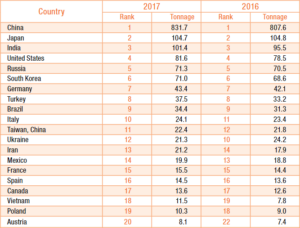By Patrick Martin
Steel is the backbone of the American economy. While a steel beam may not be found on the average person’s grocery list, it has an impact – direct or indirect — on virtually every aspect of our lives – even bananas. Although they obviously contain no steel, an increase in the price of steel makes the cargo ships that send bananas to you more expensive, and that eventually could make the bananas more expensive.
Think of it as the most elaborate, complicated domino effect you’ve ever seen, because steel affects all of the goods you buy and every construction site you see. And it all begins with one gigantic steel domino.
How large is this steel domino? In 2017, the world produced approximately 1.689 billion tons of steel. The top 20 producers are arranged by the World Steel Foundation (WSF). The WSF also states that there are over 3,500 different grades of steel with many different properties for different uses. A great majority of types have just been invented in the past 20 years with efficiency, cost, and safety in mind. The WSF says that if the Eiffel Tower were to be rebuilt today, the engineers would only need one-third of the steel that was originally used, due to these new types of steel.
The U.S. has historically been a ravenous consumer of steel from other countries and no longer produces much of its own. In fact, it is the world’s largest steel importer, importing 34.6 million metric tons from 85 countries in 2017. The top three import sources are Canada, Brazil, and South Korea, according to the International Trade Administration. Thus, the actual making of steel is a relatively small part of the economy, with U.S. steel mills employing 140,000 people in 2015. Steel-consuming industries, however, employed more than 6.5 million people and added $1 trillion to the economy in the same year.
In 2003, the United States lifted the most recent steel tariff, allowing for the market to flourish. During these 15 years, the price of different steels settled at their natural levels. If an American steel mill could produce cheap, good steel, it would be bought and used. If steel from other countries was available, it would be used. Why does the production of U.S. steel employ so few people? The process has become exponentially more efficient, with only 1.5 man-hours of work needed to produce a ton of steel today, compared to 10.1 man-hours in the 1980s.
The notion of importing large quantities of any needed resource offends those with protectionist views. Protectionism is the economic and cultural perspective that imports are a negative thing, and tariffs are needed to eliminate the availability of imports. For this reason, President Trump enacted heavy-handed tariffs on steel (25%) and aluminum (10%) on March 23, mainly only against China. On May 31, Trump imposed these tariffs on Canada, Mexico, and the European Union, some of the U.S. closest allies.
As a result, foreign steel is now 25% more expensive to buy. The protectionists’ hopes are that consumers will turn to American-made steel, and more jobs will be created. The effect, however, is that American steel and aluminum factories are not equipped for this rise in demand. This means that the price for U.S. steel rises as well, which hurts consumers and Americans working in the trillion-dollar industries that use large quantities of steel. A study by the Trade Partnership concludes that five jobs will be lost for every one job gained from the tariffs, a total loss of 146,000 jobs.
Because this policy affects only raw steel, finished products are not taxed on import. For example, American businesses that build steel wheels for trucks or RVs and want to buy foreign steel and manufacture their product in the U.S. would now have to pay more for that steel. However, if a foreign company makes the same steel wheels with their cheaper material and then ships them here, that import is not taxed, completely undercutting the American finished product.
That’s just a sample of the impact on the domestic front. Abroad, the steel tariff has also offended some of our closest allies. Blocking free trade with close allies such as Mexico, Canada, and the EU has offended those countries. As a result, the U.S. must now deal with a collective $40 billion of retaliatory tariffs, each country pinpointing exactly which goods would be affected: Mexican officials stated that they specified “steel from Vice President Mike Pence’s home state of Indiana, motorboats from Senator Marco Rubio’s Florida, and agricultural products from the California district of Representative Kevin McCarthy, the House majority leader.”
Angela Hofmann, deputy director of Farmers for Free Trade, told the New York Times in a statement: “These tariffs will exact immediate and painful consequences on many American farmers. Hog, apple, potato and dairy farmers are among those suddenly facing a 10 or 20 percent tax hike on the exports they depend on for their livelihoods. Farmers need certainty and open markets to make ends meet. Right now they are getting chaos and protectionism.”
The U.S. has tried a very similar policy before. During an economic downturn that began with the dot-com crash near the end of the Clinton Administration, President George W. Bush enacted temporary tariffs of 8-30% in March of 2002. He lifted them in 2003, two years earlier than the scheduled cutoff of 2005. These tariffs, also on imported steel, applied globally except for Canada and Mexico. This was according to NAFTA, a treaty whose provisions President Trump didn’t follow. A study by The World Economy found that this temporary tariff negatively affected U.S. Gross Domestic Product and employment. Let’s hope the current administration can act on lessons learned in the past before the iron grows cold.
Patrick Martin is a Florida State University junior studying Economics and Political Science.He is currently a policy intern at The James Madison Institute.
Sources:

https://www.trade.gov/steel/countries/pdfs/imports-us.pdf?forcedefault=true
https://reason.com/blog/2018/04/25/massive-spike-in-american-steel-prices
https://www.nytimes.com/2018/06/05/us/politics/trump-trade-canada-mexico-nafta.html
https://www.farmersforfreetrade.com/farmers-free-trade-statement-mexican-retaliation-232-tariffs/











